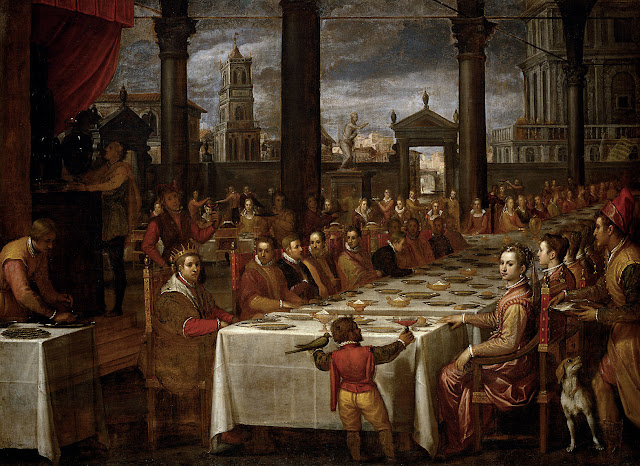 |
| Domenico Cresti (Il Passignano) Cain slaying Abel ca. 1590-1600 drawing Rijksmuseum, Amsterdam |
 |
| Domenico Cresti (Il Passignano) Banquet of Ferdinando I de' Medici, Grand Duke of Tuscany ca. 1590 oil on canvas Kunsthistorisches Museum, Vienna |
 |
| Domenico Cresti (Il Passignano) Angels transporting the Relics of San Giovanni Gualberto 1593-94 fresco Cappella delle Reliquie di San Giovanni Gualberto, Passignano |
 |
| Domenico Cresti (Il Passignano) King Louis IX of France adoring the Arm of San Giovanni Gualberto 1593-94 fresco Cappella delle Reliquie di San Giovanni Gualberto, Passignano |
 |
| Domenico Cresti (Il Passignano) Relics of San Giovanni Gualberto exorcising a Demon 1593-94 fresco Cappella delle Reliquie di San Giovanni Gualberto, Passignano |
 |
| Domenico Cresti (Il Passignano) Resurrection 1598 oil on canvas Basilica della Santissima Annunziata, Florence |
"Passignano's Venetian education was allowed to show itself more openly in his succeeding paintings of the nineties. Some . . . take on a character like that of works of Palma Giovane's school. When the relation becomes so apparent, we realize that Passignano's contribution to the Florentine reform, at least within the limits of the sixteenth century, must be measured more in terms of a borrowing he was able to pass on to his native school than in those of any major innovation of his own. Yet in the first years of the new century he achieved a mode, combining Venetian mobility of forms and lights with a more literal descriptive naturalism, which was influential for the subsequent development of Florentine seventeenth-century style."
– S.J. Freedberg from Painting in Italy - 1500 to 1600 in the Pelican History of Art series (London, 1971)
 |
| Domenico Cresti (Il Passignano) Bathers at San Niccolò 1600 oil on canvas private collection |
"Passignano's painting of men bathing is a picture of tantalizing paradoxes: it can be associated with a tradition of bath house and bathing pictures going back to antiquity while at the same time being totally unique. . . . Painted with Passignano's renowned rapidity and bravura, beautiful in its surface qualities, the picture combines close observation of reality with an idealizing vision of friendship and possibly love. Proudly signed and dated 1600 in the center foreground, it is exceptional among Passignano's works, which consisted largely of a conventional blend of religious and historical subjects and portraiture. Nothing is known of its origins. . . . The painting's scale – also remarkable for a genre scene that is hardly generic – proves that it was a significant commission and an important one for the original owner who must have been a Florentine with fond associations of summer days at San Niccolò, which is recognizably portrayed."
– from promotional text issued by Sotheby's prior to the New York auction in January 2017 when the painting sold for the relatively low sum of $732, 500
 |
| Domenico Cresti (Il Passignano) Miracle of St Michael Archangel and the Ox of Gargano 1601 oil on canvas Abbazia di San Michele Arcangelo, Passignano |
 |
| Domenico Cresti (Il Passignano) Allegorical Virtue - Fortitude 1601 fresco Abbazia di San Michele Arcangelo, Passignano |
 |
| Domenico Cresti (Il Passignano) Allegorical Virtue - Justice 1601 fresco Abbazia di San Michele Arcangelo, Passignano |
 |
| Domenico Cresti (Il Passignano) Allegorical Virtue - Prudence 1601 fresco Abbazia di San Michele Arcangelo, Passignano |
 |
| Domenico Cresti (Il Passignano) Allegorical Virtue - Temperance 1601 fresco Abbazia di San Michele Arcangelo, Passignano |
 |
| Domenico Cresti (Il Passignano) St Sebastian carried to the Sepulchre 1602 oil on canvas Museo di Capodimonte, Naples |
 |
| Domenico Cresti (Il Passignano) Christ healing the Blind Man 1604 oil on canvas Basilica della Santissima Annunziata, Florence |